Make large shapes on the floor. Describe a rule that focuses on the defining parts of shapes (sides and angles) and properties of shapes (relationships between parts). For example, “jump on a shape with four straight sides and four angles” or “jump on a shape with all sides equal length.” Then children quickly jump on appropriate shapes. Have children explain why the shapes they jumped on were correct examples of the shape (or discuss why they are not correct). State another rule and play again.
Primary Objectives
- Use essential attributes to name and describe shapes (for example, a triangle has three straight sides and three angles)
- Understand shape properties, or the relationship between parts of shapes (for example, a square has four equal-length sides)
- Understand angle size (for example, bigger or smaller angle, right angle)
How To Use
- First, introduce the activity to the WHOLE GROUP.
- Then, engage children in the activity in SMALL GROUPS.
- Once the children are very familiar with the activity, they can play it independently at CENTER TIME with slight modifications.
If most of your children are not yet able to recognize and name most shapes, you may want to instead preview the Shape Names version. If most of your children are able to name most shapes but are not yet able to describe shapes based on their defining features (how many sides and angles most shapes have), they may benefit from the Parts of Shapes version.
Materials
- Painter’s tape or sidewalk chalk
- Sample shape layouts
- Sample rules for where to jump
- White board and marker (optional)
- Steps
Teacher Resources
- Sample shape layouts
- Sample rules for where to jump
- Shape glossary with sample language to use when describing shapes to children; also features additional shape examples and non-examples.
Steps of the activity
The activity steps icons below outline the steps of the activity. Find a sample script for teachers to use here.

Step 1
Teacher states a rule indicating which shapes are “safe” to jump on.
Step 2
Children jump on a shape based on the rule.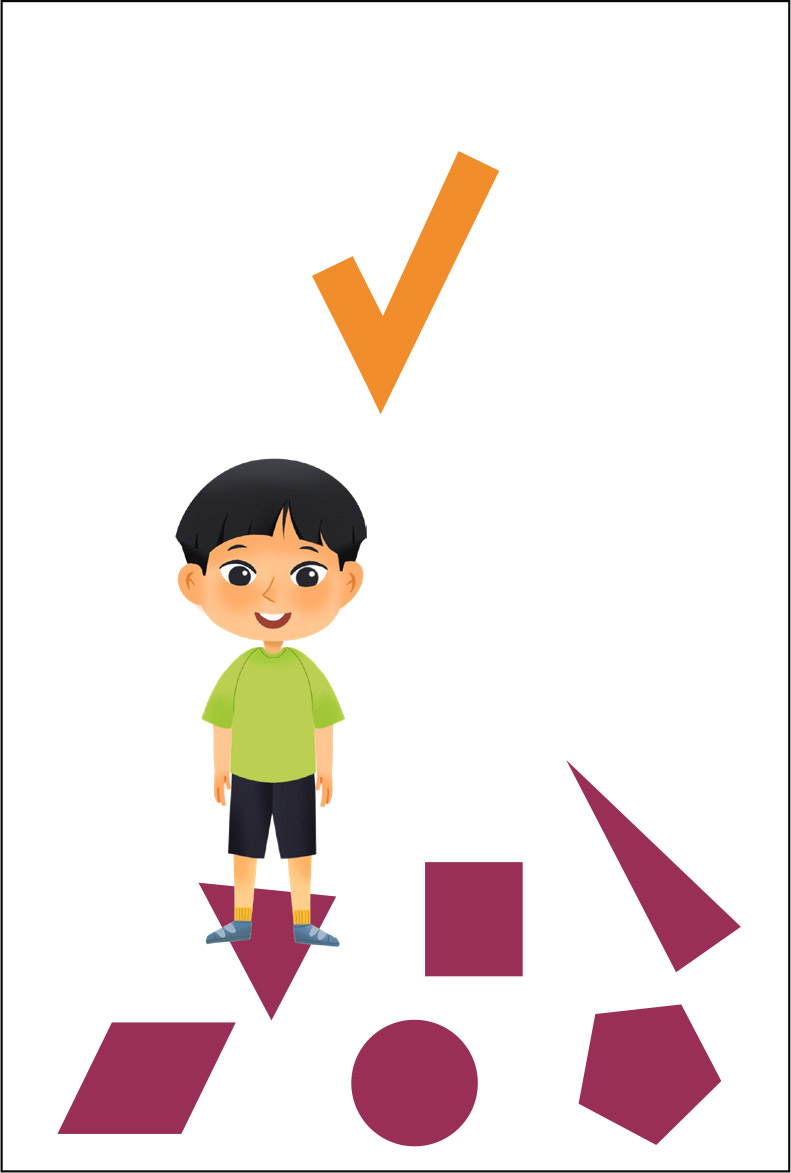
Step 3
Teacher checks children’s chosen shapes.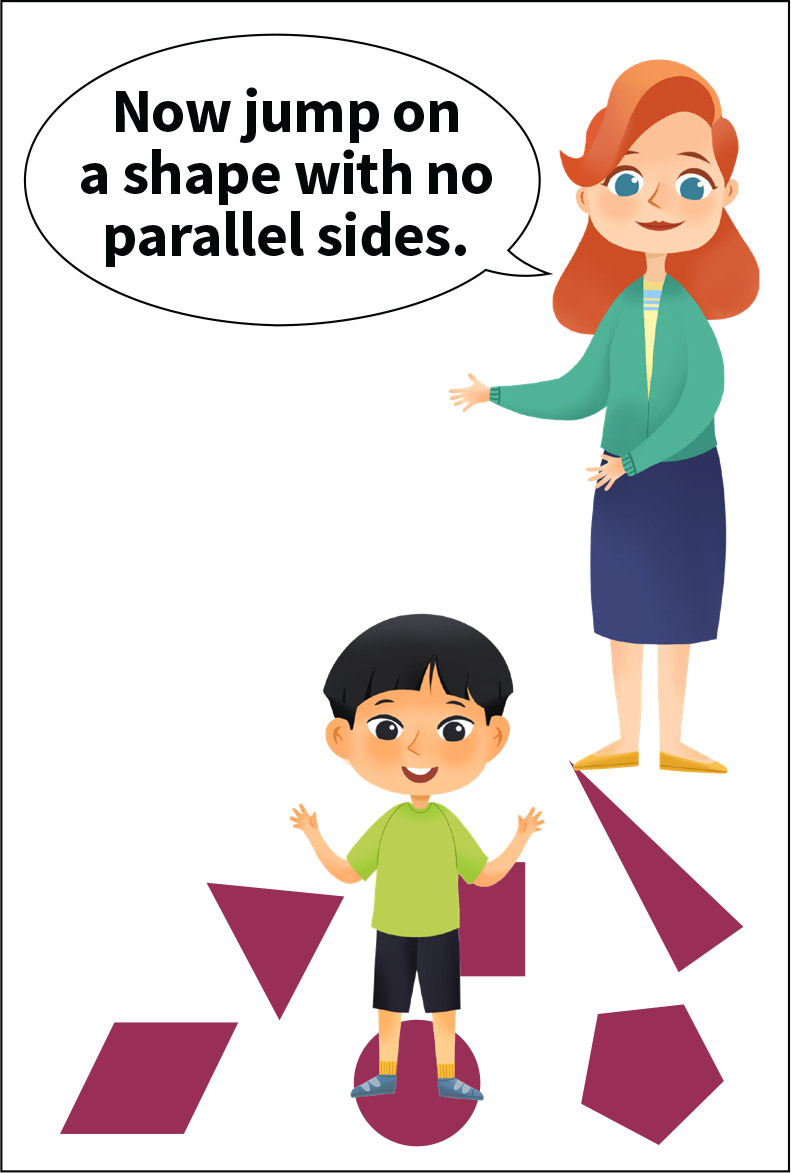
Step 4
Teacher states another rule and repeat steps 1-3.Instructions
Instructions for introducing the activity to the Whole Group .
| Activity Set-Up | |
|
Outline or draw shapes on the floor or ground ahead of time, using the sample shape layout handout for shape ideas based on children’s knowledge of shapes. We recommend including a minimum of 10 shapes, with one per child if you have more than 10 children in your group. MAKE IT EASIER
MAKE IT HARDER
|
|
| Activity Warm-Up | |
Let’s practice some shapes! Ready… here we go! |
Show examples of shapes you will be using during the activity (for example, from paper shape sets or drawings on a white board), name the shapes that will be included in the activity, and describe some of their key properties (such as four right angles, two pairs of parallel sides). If you’re introducing new shapes to children, consider using the shape glossary for language and tips. |
| Introduce the Activity | |
We’re going to pretend that our classroom floor (or playground if outside) and some of these shapes are hot lava! So you don’t burn your feet, you have to jump (step) on the safe shapes. This activity gets you thinking more about the parts that make up a shape, for example, whether the sides are the same length, what kind of angles the shape has, and other things like that. I will describe which shapes are safe. You figure out which shapes fit the rule and then jump on them so you don’t burn your feet! |
|
| Model the Activity | |
|
Choose two to three children to help demonstrate the activity. |
|
As an example, Shapes with four right angles are the safe shapes! Jump on all the shapes that have four right angles so you don’t burn your feet! |
Present a rule focused on shape properties and attributes for children to jump on a particular shape. Use the suggested rules handout for recommended rule ideas based on children’s knowledge of shapes. Children respond by jumping on the appropriate shapes. There may be more than one child on each shape. If, after children choose a shape, there are still shapes available that fit the rule, encourage some children to find another shape. MAKE IT EASIER
You can also use Stop and Go cards to separate “planning” time (when children state the rule) from “action” time (when children start to move to shapes). Hold up the red stop card while children plan their next move to their next shape, and hold up the green card to cue children to move. MAKE IT HARDER
Use a NOT rule (for example, Jump on shapes that are not triangles).
Use an EITHER/OR rule (for example, Jump on shapes with more than three sides or all right angles). |
The rest of us need to watch them to make sure they are not burning their feet. Let’s tell them if they do! |
To keep the children who are not in the activity engaged, ask them to make sure the children jumping are jumping on the correct shapes, and encourage them to tell them if they are. MAKE IT EASIER
MAKE IT HARDER
|
|
Continue with different groups of children and different shape rules until all children have had a turn or as time allows. |
|
Summary of Activity Adaptations
This is a summary of all the available adaptations to make Don’t Burn Your Feet easier or harder to accommodate the needs of your students. Whether the adaptation is easier or harder depends on each student’s math or executive function (EF) skills.
Explore The Executive Function And Math Skills In This Activity
- Shapes levels
What to do next
Are some students ready for more challenge? Try the adaptations above provided for Whole Group. On another day, play in pairs in Small Group .
If most of your children are not yet able to recognize and name most shapes, you may want to instead preview the Shape Names version. If most of your children are naming all shapes but are not yet able to describe shapes based on their defining features (how many sides and angles most shapes have), they may benefit from the Parts of Shapes version.
Materials
- Painter’s tape or sidewalk chalk
- Sample shape layout handout
- Suggested rules handout to read to students to tell them where to jump
- White board and marker (optional)
- Steps
Teacher Resources
Shape glossary handout with sample language to use when describing shapes to children; also features additional shape examples and non-examples.
Steps of the activity
For small groups, we suggest four children arranged groups of four with a teacher present to provide guidance.
The activity step icons below outline the steps of the activity. Find a sample script for teachers to use here.
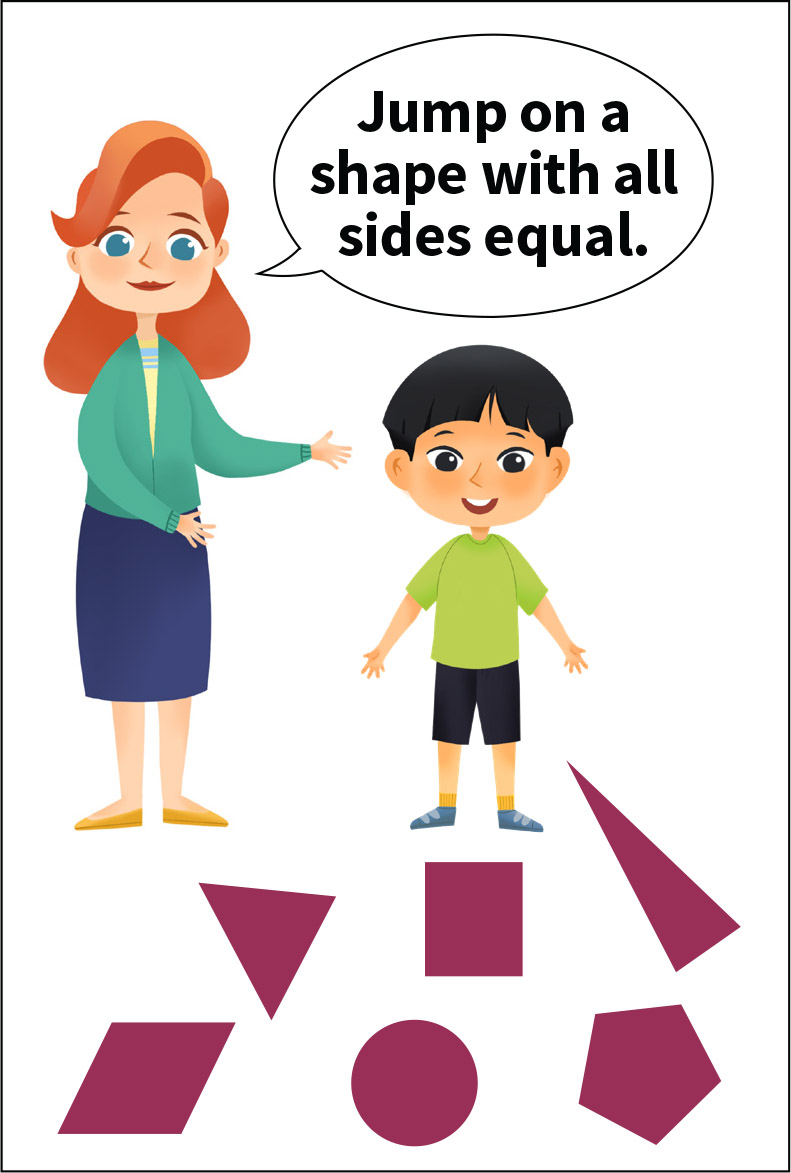
Step 1
Teacher states a rule indicating which shapes are “safe” to jump on.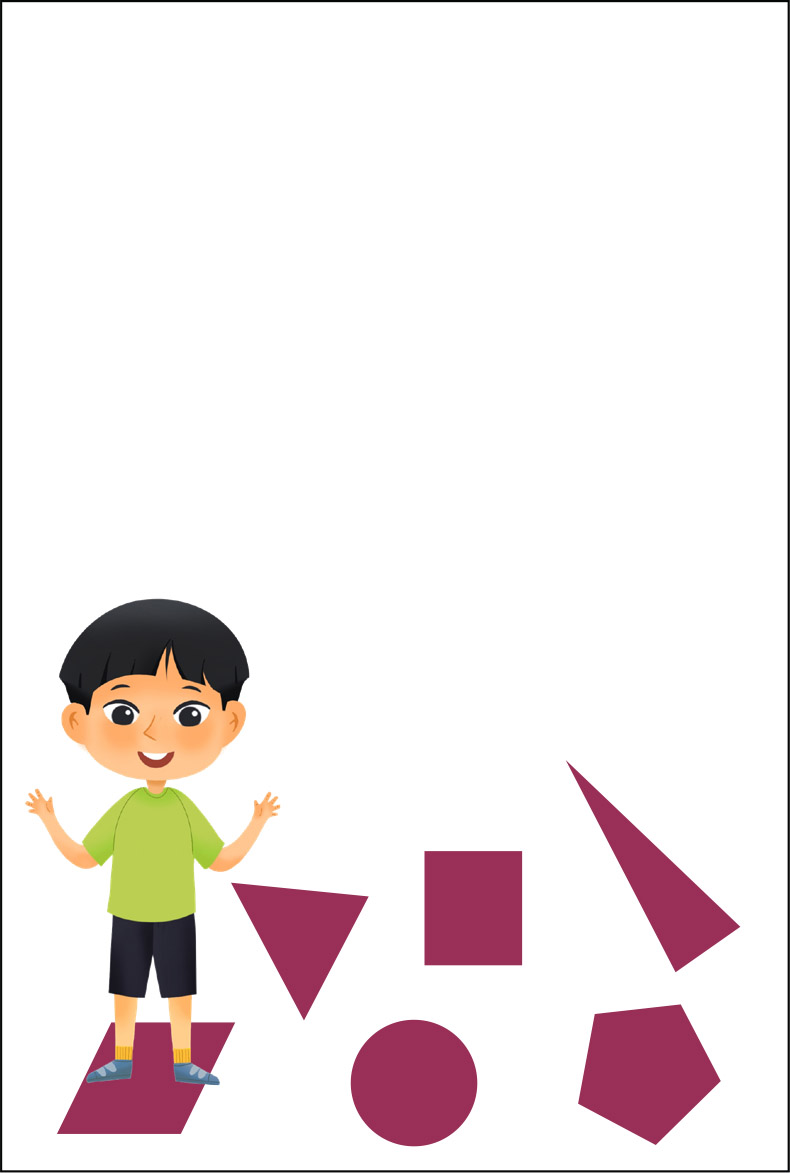
Step 2
Children jump on a shape based on the rule.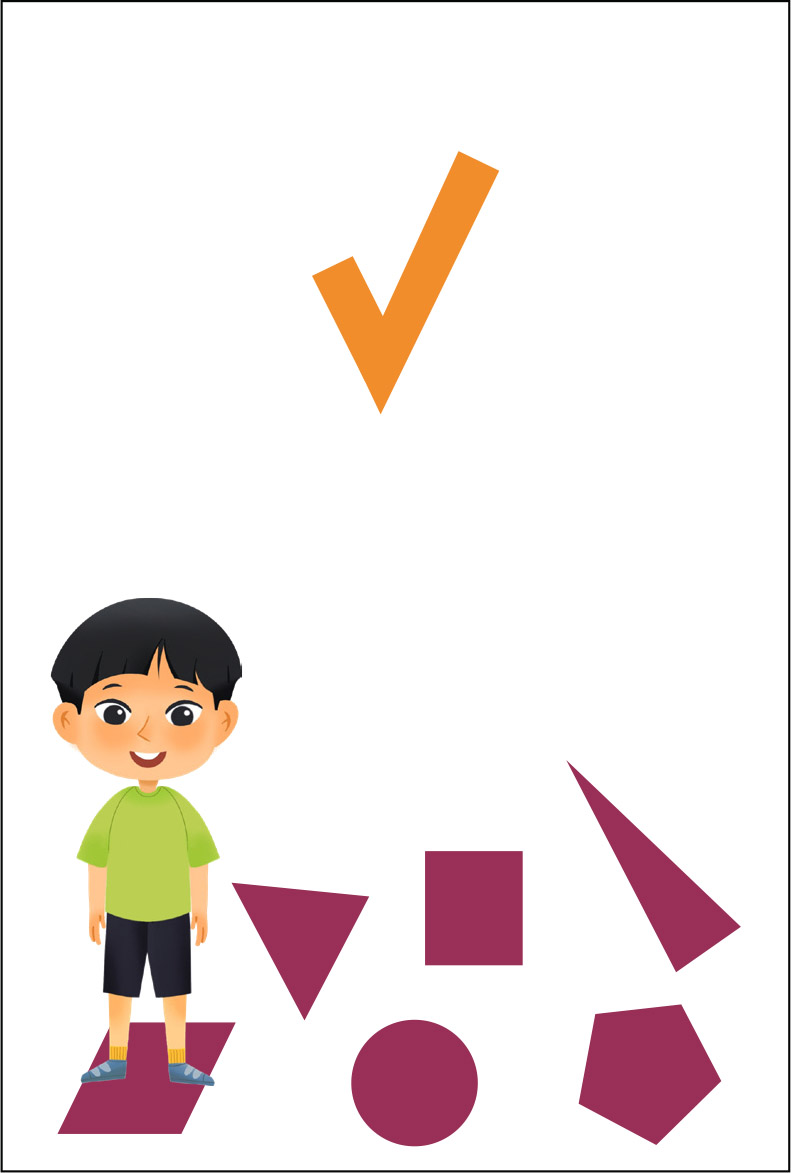
Step 3
Teacher checks children’s chosen shapes.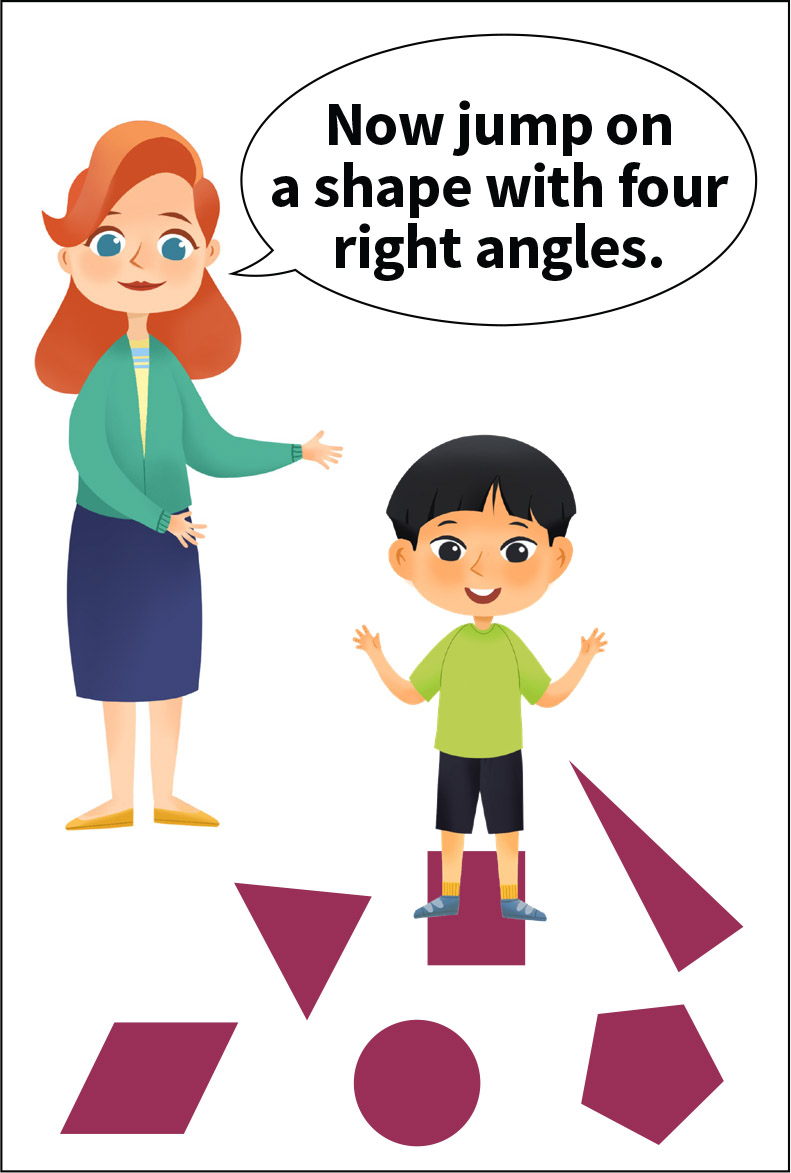
Step 4
Teacher states another rule and repeat steps 1-3.Instructions
Instructions for introducing the activity to Small Group and preparing to play in groups of four.
| Activity Set-Up | |
|
Outline or draw shapes on the floor or ground ahead of time, using the Don’t Burn Your Feet shapes handout for shape ideas based on children’s knowledge of shapes. We recommend including a minimum of 10 shapes. Both pairs of children will use the same shapes during play. MAKE IT EASIER
MAKE IT HARDER
|
|
| Introduce the Activity | |
We’re going to pretend that our classroom floor (or playground if outside) and some of these shapes are hot lava! So you don’t burn your feet, you have to jump (step) on the safe shapes. This activity gets you thinking more about the parts that make up a shape, for example whether the sides are the same length, what kind of angles the shape has, and other things like that. I will describe which shapes are safe. You figure out which shapes fit the rule and then jump on them so you don’t burn your feet! |
|
As an example, Shapes with four sides of equal lengths are the safe shapes! Jump on all the shapes that have four sides of equal lengths so you don’t burn your feet! |
Present a rule that focuses on the shape properties and attributes. Use the Don’t Burn Your Feet rules handout for recommended rule ideas based on children’s knowledge of shapes. For this version, focus on the properties and attributes of shapes. Properties are the relationships between parts, such as sides the same length, vertices all the same size, sides that make a right angle, and parallel sides. Children respond by jumping on the appropriate shapes. There may be more than one child on each shape. If, after children choose a shape, there are still shapes available that fit the rule, encourage some children to find another shape. MAKE IT EASIER
You can also use Stop and Go Mediator Cards to separate “planning” time (when children state the rule) from “action” time (when children start to move to shapes). Hold up the red stop card while children plan their next move to their next shape, and hold up the green card to cue children to move. MAKE IT HARDER
Use a rule with negation: a NOT rule (for example, Jump on shapes that are not triangles).
Use a union rule: an EITHER/OR rule (for example, Jump on shapes with more than three sides or all right angles). |
Now, freeze in place! |
Have children remain on the shapes they chose. |
How do you know the shape you jumped on is a safe shape? Does this shape have [the property or attribute stated in the rule]? |
Have children explain why the shapes they jumped on were correct. If children are incorrect, ask other children to discuss which shapes fit the rule and why, and allow children to attempt to self-correct and try again. If you need to intervene, direct their attention to what does and does not fit the description, gesturing to specific parts of the shape. MAKE IT EASIER
MAKE IT HARDER
|
|
Repeat with additional rules. |
|
Summary of Activity Adaptations
This is a summary of all the available adaptations to make Don’t Burn Your Feet easier or harder to accommodate the needs of your students. Whether the adaptation is easier or harder depends on each student’s math or executive function (EF) skills.
Explore The Executive Function And Math Skills In This Activity
- Shapes levels
What to do next
Did some students need more support or more challenge? Try some of the adaptations provided above for Small Group. Continue working in small groups with teacher support until students can comfortably play with minimal teacher guidance. While there are no Center Time instructions for Shape Parts & Attributes, students can play Shape Names or Parts of Shapes independently in centers throughout the year.